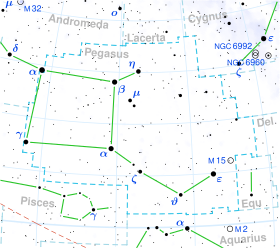31 Pegasi
Appearance
| Observation data Epoch J2000 Equinox J2000 | |
|---|---|
| Constellation | Pegasus |
| Right ascension | 22h 21m 31.07511s[1] |
| Declination | 12° 12′ 18.6628″[1] |
| Apparent magnitude (V) | 4.99[2] |
| Characteristics | |
| Spectral type | B2IV-Ve[3] |
| U−B color index | -0.81[2] |
| B−V color index | -0.10[2] |
| Variable type | γ Cas[4] |
| Astrometry | |
| Radial velocity (Rv) | -5.30[5] km/s |
| Proper motion (μ) | RA: +6.32[1] mas/yr Dec.: +4.80[1] mas/yr |
| Parallax (π) | 2.01 ± 0.28 mas[1] |
| Distance | approx. 1,600 ly (approx. 500 pc) |
| Absolute magnitude (MV) | -3.61[6] |
| Details | |
| Mass | 11.9[7] M☉ |
| Luminosity | 5582[6] L☉ |
| Surface gravity (log g) | 3.71[8] cgs |
| Temperature | 23,890[8] K |
| Rotational velocity (v sin i) | 98[8] km/s |
| Other designations | |
| Database references | |
| SIMBAD | data |
31 Pegasi (31 Peg) is a class B2IV-V[3] (blue subgiant) star in the constellation Pegasus. Its apparent magnitude is 4.99[2] and it is approximately 1600 light years away based on parallax.[1]
It is a γ Cas variable, a type of shell star with a circumstellar disc of gas surrounding the star at the equator, ranging from 5.05 to 4.85 magnitude.[4]
References
- ^ a b c d e f Van Leeuwen, F. (2007). "Validation of the new Hipparcos reduction". Astronomy and Astrophysics. 474 (2): 653. arXiv:0708.1752. Bibcode:2007A&A...474..653V. doi:10.1051/0004-6361:20078357. Vizier catalog entry
- ^ a b c d Ducati, J. R. (2002). "VizieR Online Data Catalog: Catalogue of Stellar Photometry in Johnson's 11-color system". CDS/ADC Collection of Electronic Catalogues. 2237. Bibcode:2002yCat.2237....0D.
- ^ a b Hoffleit, D.; Warren, W. H. (1995). "VizieR Online Data Catalog: Bright Star Catalogue, 5th Revised Ed. (Hoffleit+, 1991)". VizieR On-line Data Catalog: V/50. Originally published in: 1964BS....C......0H. 5050. Bibcode:1995yCat.5050....0H.
- ^ a b Samus, N. N.; Durlevich, O. V.; et al. (2009). "VizieR Online Data Catalog: General Catalogue of Variable Stars (Samus+ 2007-2013)". VizieR On-line Data Catalog: B/gcvs. Originally published in: 2009yCat....102025S. 1. Bibcode:2009yCat....1.2025S.
- ^ Gontcharov, G. A. (2006). "Pulkovo Compilation of Radial Velocities for 35 495 Hipparcos stars in a common system". Astronomy Letters. 32 (11): 759. arXiv:1606.08053. Bibcode:2006AstL...32..759G. doi:10.1134/S1063773706110065.
- ^ a b Anderson, E.; Francis, Ch. (2012). "XHIP: An extended hipparcos compilation". Astronomy Letters. 38 (5): 331. arXiv:1108.4971. Bibcode:2012AstL...38..331A. doi:10.1134/S1063773712050015. Vizier catalog entry
- ^ Tetzlaff, N.; Neuhäuser, R.; Hohle, M. M. (2011). "A catalogue of young runaway Hipparcos stars within 3 kpc from the Sun". Monthly Notices of the Royal Astronomical Society. 410: 190. arXiv:1007.4883. Bibcode:2011MNRAS.410..190T. doi:10.1111/j.1365-2966.2010.17434.x.
{{cite journal}}: CS1 maint: unflagged free DOI (link) Vizier catalog entry - ^ a b c Zorec, J.; Frémat, Y.; Domiciano De Souza, A.; Royer, F.; Cidale, L.; Hubert, A.-M.; Semaan, T.; Martayan, C.; Cochetti, Y. R.; Arias, M. L.; Aidelman, Y.; Stee, P. (2016). "Critical study of the distribution of rotational velocities of Be stars". Astronomy & Astrophysics. 595: A132. Bibcode:2016A&A...595A.132Z. doi:10.1051/0004-6361/201628760.

